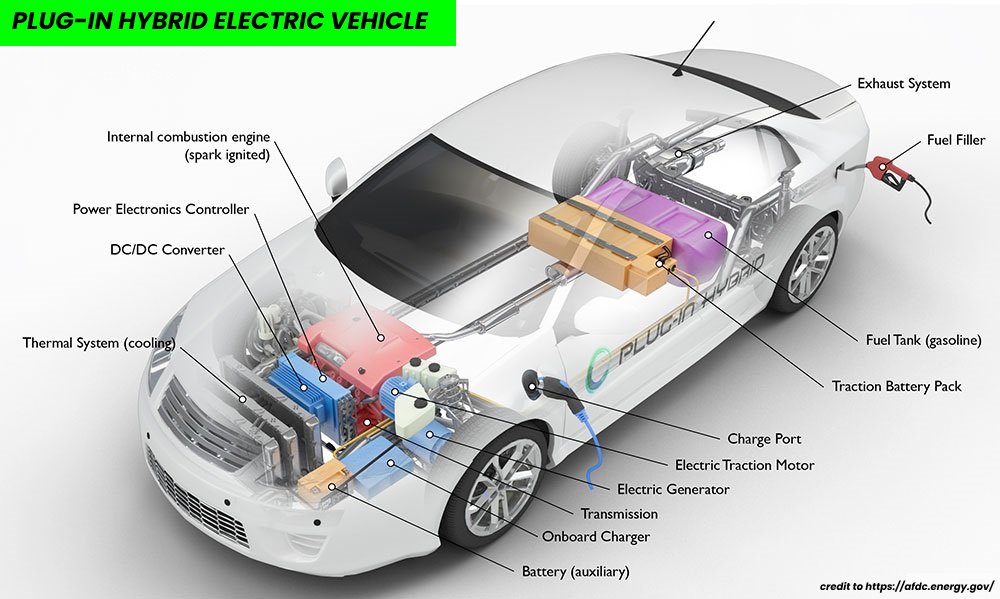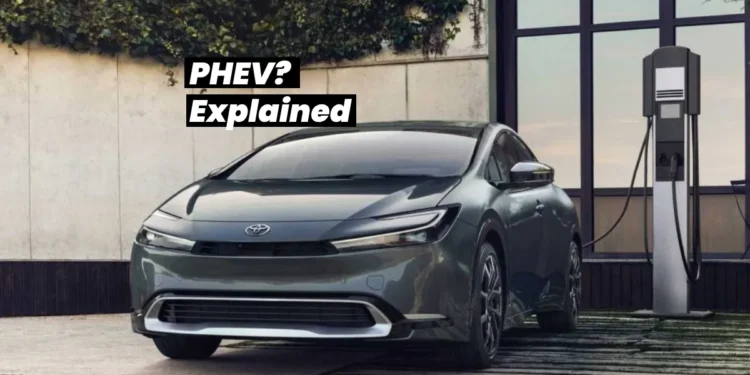Table of Contents
Plug-in Hybrid Electric Vehicles Basics
1. Overview
Plug-in hybrid electric vehicles (PHEVs) are a combination of pure electric vehicles and gasoline or diesel powered vehicles, so they have a battery pack with an electric motor, alongside with a gasoline tank with an internal combustion engine. The battery pack in a plug-in hybrid vehicle (PHEV) is generally larger than the ones used in hybrid vehicles (HEV). The fact that the battery packs are larger in PHEV than HEV allows the vehicle to operate predominantly on electricity during short trips. For longer trips, a PHEV can draw fuel from its onboard tank and turn on the internal combustion engine. PHEVs produce lower levels of emissions, depending on the electricity source and how often the vehicles are operated in all-electric mode. The battery can be charged through an EV charger by plugging it into an electric power source. Additionally, regenerative braking and the internal combustion engine also contribute to recharging the battery. Although plug-in hybrid electric cars are generally more expensive than conventional and hybrid electric cars, some cost can be recovered through fuel savings or federal tax credit.
(Check out our article on: Top 10 PHEVs in 2023)
2. What are the key components of a Plug-in Hybrid Electric Vehicle?

The key components of a Plug-in Hybrid Electric Vehicle are :
- Electric traction motor : By pulling energy from the battery pack, the electric motor drives the vehicle’s wheels. Some cars use motor generators that perform both functions, driving the car and electricity generation.
- Electric generator : As we said earlier plug-in hybrid electric vehicles have that functionality of regenerative braking and this in some cars is done using separated equipment called Electric generator which generates electricity while braking but some PHEVs use motor generators to do that.
- DC/DC Converter : This device converts DC high-voltage coming from the battery pack to DC low-voltage in order to feed the vehicle accessories and recharge the auxiliary battery.
- Traction Battery pack : The battery pack, consisting of rechargeable lithium-ion cells is used to store electricity for use by the Electric traction motor. The higher the kW of a battery is the more miles the car will travel in pure electric mode.
- Onboard charger : This unit is the one responsible for converting incoming AC current coming from the charge port to DC power in order to charge the battery. It also communicates with the EV charger and monitors battery characteristics such as state of charge and other characteristics while charging.
- Power electronics controller : This equipment manages the flow of electrical energy coming from the battery pack and delivered to the electric motor controlling its speed and the torque it produces.
- Charge port: The charge port allows the vehicle to be connected to an external power supply in order to charge the battery pack.
- Auxiliary battery : The role of this battery is it provides electricity to start the car before the traction battery pack kicks in and it also powers vehicle accessories.
- Internal combustion engine : in an internal combustion engine the fuel is injected into the intake manifold or the combustion chamber, where it is combined with air, and the air/fuel mixture is ignited by the spark from a spark plug.
- Fuel tank : This unit stores the fuel on board the vehicle until it is needed by the engine.
- Fuel filler : A fuel filler is the opening through which fuel (gasoline or diesel) is added to a vehicle’s fuel tank. This opening is generally located on the exterior of the vehicle and often on the back of the car. It is covered by a fuel filler cap to protect the fuel system from dust, debris, and unauthorized elements.
- Exhaust system : The role of exhaust system is to channel exhaust gases coming from the engine out through the tailpipe. PHEVs are equipped with a three-way catalyst designed to reduce engine-out emissions within the exhaust system.
- Transmission : The mechanical power coming from the electric motor/engine is transferred to the wheels via the transmission system to drive the car.
- Thermal management system : This unit usually consists of a radiator, fan and a coolant pump and it helps to maintain a proper operating temperature range of the engine, battery pack, electric motor, and power electronics inside the car.
3. How far will a plug-in hybrid electric vehicle go?
Since plug-in hybrid electric vehicles are equipped with an internal combustion engine which can be powered by petrol/diesel fuel, the range that can go is the addition of the range given by the battery pack and the petrol/diesel tank. Depending on which model, battery range is typically 25-35 miles, but can be as much as 50-60 miles with the latest technology, and when the battery gets discharged of all its energy, the petrol or diesel engine kicks in giving the car another 250-350 miles. Here are some samples of PHEVs existing right now on the market with the battery range of each one of them :
- Toyota RAV4 Prime : 68 km (42 miles)
- Ford Escape PHEV : 60 km (37 miles)
- BMW 530e xDrive : 30 km (19 miles)
- Jeep Wrangler 4dr 4xe : 35 km (22 miles)

4. What happens when a plug-in hybrid electric car runs out of charge?
Since a plug-in hybrid electric car has both a battery pack and a petrol/diesel engine, when a PHEV runs out of battery, the internal combustion engine takes over and allows you to continue your journey.
5. Advantages and Disadvantages of plug-in hybrid Electric Vehicles?
Plug-in Hybrid Electric Vehicles are now growing in popularity every day. And like any car there are certain benefits and drawbacks of using a plug-in hybrid electric car and here are the top few to keep in mind :
Advantages :
- Cost of driving is less than a conventional car, because electricity costs less, so driving a PHEV in pure electric mode for your daily needs can save you some money.
- Plug-in Hybrid Electric cars reduce emissions because they can be driven in pure electric mode.
- Plug-in Hybrid Electric cars are smooth and quiet when operating in a pure electric mode which is most used in daily usage, particularly in traffic and around town.
- Federal tax credit.
Disadvantages :
- Plug-in hybrid electric cars still come with running costs compared to battery electric vehicles. Unlike BEVs, PHEVs have an internal combustion engine which means that you still need to budget for maintenance when it comes to the mechanical side of it.
- Plug-in Hybrid electric cars can be a lot more expensive out of the gate compared to petrol or diesel equivalents.
- Relatively a new technology they’re not yet common on the market, so it’s hard to predict their resale value.
- Complex to maintain.
















